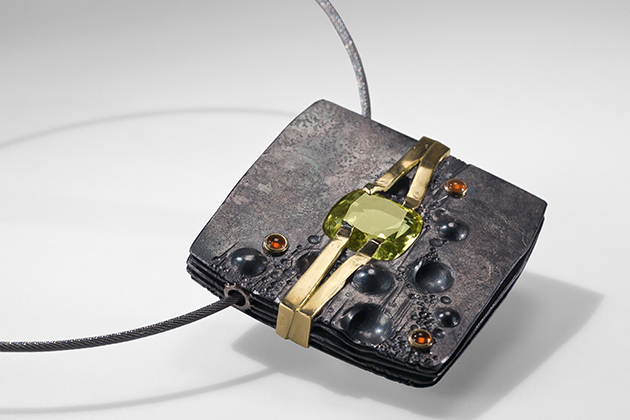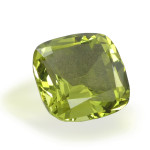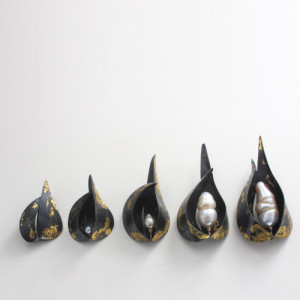II. LE DECRYPTAGE DES CRÉATEURS
Qu’est-ce que l’épigénétique ?
Après avoir décrypté le code génétique de nombreuses espèces dont l’homme, les scientifiques ont réalisé qu’ils ne tenaient pas encore la clé pour expliquer tous les mystères de la vie, des maladies et de notre évolution… En effet, il existe encore un autre niveau de complexité qui permet une régulation fine de l’expression des gènes.
C’est là qu’entre en scène l’épigénétique dont les premiers résultats ont été de montrer que des changements sur notre « patrimoine génétique » peuvent être modulés par l’interaction avec l’environnement et d’autres facteurs.
L’environnement influencerait donc des informations transmises par les gènes. Afin de faire écho à ce phénomène, la galerie Elsa Vanier a proposé à ses créateurs de créer un bijou en utilisant une pierre issue d’un même cristal (un quartz citrine jaune-vert taillé en coussin ou un grenat mandarin taillé de différentes façons), afin que chacun l’interprète selon son inspiration, et exprime les réflexions que ces recherches scientifiques ont suscitées.
Voici, pour la citrine, quartz jaune-vert à l’éclat étonnant, ce que les 3 créateurs participant au salon Révélations ont proposé :
AGATHE SAINT GIRONS
Pour l’exposition “Épigénétique, épi-quoi encore ?”, les bijoux d’Agathe Saint Girons incarnent l’être humain modifié par son environnement.
Interrogeant l’évolution des matières, des procédés et de la notion de précieux, Agathe Saint Girons a choisi de sertir la pierre dans de la corne.
For the « Epigenetics, and so what ?” exhibition, Agathe Saint Girons has created jewelry that embody the idea of human cells being modified by our environment. Questioning materials’ evolution and the meaning of preciousness, she chose to set the above gemstone, a yellow-green citrine thanks to an innovative process.
CLAIRE WOLFSTIRN
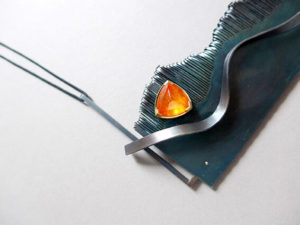
Claire Wolfstirn a créé un pendentif qui permet au porteur de rendre visible ou de cacher la citrine coussin jaune-vert, mettant en scène un phénomène révélé par les découvertes épigénétiques. Le pendentif a donc deux « portés » différents.
Claire has created a pendant in which the yellow-green cushion-cut citrine can be shown or hidden by the wearer. She was inspired by the epigenetics findings that genes get switched on or off under the influence of our environment.
MARTIN SPRENG
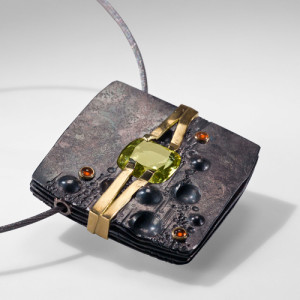 Avec la troisième citrine, Martin Spreng a créé un pendentif où la pierre est cernée de part et d’autre par un double ruban d’or jaune, évoquant ainsi le ruban déployé donnant à lire des informations génétiques. L’acier oxydé, en strates fines, évoque, lui, l’aspect tri-dimensionnel des couches d’informations.
Avec la troisième citrine, Martin Spreng a créé un pendentif où la pierre est cernée de part et d’autre par un double ruban d’or jaune, évoquant ainsi le ruban déployé donnant à lire des informations génétiques. L’acier oxydé, en strates fines, évoque, lui, l’aspect tri-dimensionnel des couches d’informations.
Martin Spreng has set the yellow-green cushion-cut citrine in a piece of contrasting gold and gems on blackened iron. The gold ribbons recall the fine threads holding genetic information that may unfold when influenced by our environment.
Trois autres créateurs ont, par certaines pièces, élargi la thématique à la génétique et ses mutations :
MARIANNE ANSELIN
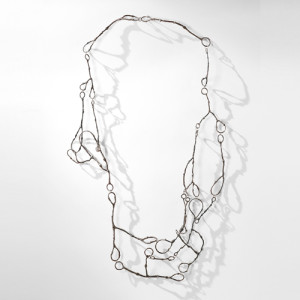 Marianne Anselin mène depuis longtemps un travail autour du bijou, de la nature et de la rencontre avec l’Autre.
Marianne Anselin mène depuis longtemps un travail autour du bijou, de la nature et de la rencontre avec l’Autre.
À partir d’une matière première glanée en forêt, son regard perçoit son devenir en bague ou collier et son travail, tout en respectant cette matière, consiste à ce que l’objet devienne bijou. « Une forme d’épigénétique ? », se demande t-elle en souriant.
Marianne a projeté son imaginaire où les branches « se modifiaient d’elles-mêmes » et devenaient bijoux, tant pour se faire remarquer que pour se protéger en devenant parure des hommes.
KAREN GAY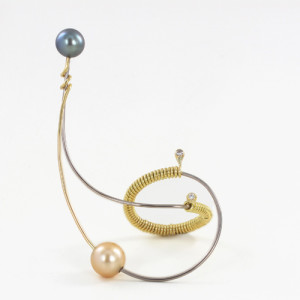
Histone’s tale : Karen Gay a été particulièrement touchée par la réflexion autour du devenir des cellules et leur évolution, de plus en plus inéluctable. Une représentation de Waddington illustre souvent les travaux en épigénétique, évoquant des billes à la croisée de chemins de vallons, passage d’un destin cellulaire à l’autre. Perles mobiles et concentré de précieux parlent pour la créatrice…
PATRICIA LEMAIRE
« Précieuses graines » :
Patricia Lemaire a axé ses réflexions autour de la “signature génétique” d’un organisme et l’image persistante de champs de blé balayés par le vent. Ainsi, par la répétition, elle illustre la mutation, la distorsion des grains de blé, dont les gènes ont été si marqués par l’environnement et les recherches génétiques récentes. De la signature génétique, Patricia Lemaire trace la signature graphique, qui évolue sous nos yeux, recherche les matières et les patines.

